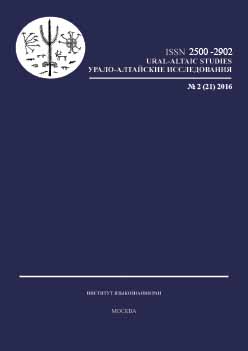Сочинительные стратегии энецкого языка
Conjunctive coordination in Enets
Author(s): Olga V. KhaninaSubject(s): Morphology, Syntax, Semantics, Comparative Linguistics
Published by: Институт языкознания Российской академии наук
Keywords: coordination; Enets; number cross-reference on verb; natural coordination;
Summary/Abstract: The paper gives a description of conjunctive coordination in Enets (both Forest and Tundra dialects) based on a corpus of natural texts. It discusses both indigenous Uralic strategies, including juxtaposition, a particle with the main meaning ‘again, also, but’, collective Dual, and double Comitative, as well as strategies based on elements borrowed from Russian, i.e. on conjunctions i, da, a. The strategies with juxtaposition, indigenous particle meaning "again, also, but", and i, borrowed from Russian, are considered main, while all the other strategies are called marginal, with the former being substantially more frequent than the latter. Syntactic properties of the main coordination strategies are studied in detail, i.e. syntactic types of coordinated elements and cross-reference of coordinated subjects and objects on the verb. A special attention is given to the semantic distribution of the main strategies: they are shown to form a hierarchy correlating with a scale from natural/expected to unnatural/unexpected coordination; besides, it turns out that the parameter of morphological homogenity is also relevant for the Enets coordination. The data are studied against a typological background, which allows to highlight rare features specific to Enets, as well as to spot cross-linguistically common phenomena. Formal properties of Enets coordination strategies are unexpectedly diverse as compared to other languages of the world: this can be explained by intermarriage of features inherited from Uralic and those borrowed from a structurally different Russian.
Journal: Урало-алтайские исследования
- Issue Year: 2016
- Issue No: 02 (21)
- Page Range: 131-148
- Page Count: 18
- Language: Russian

